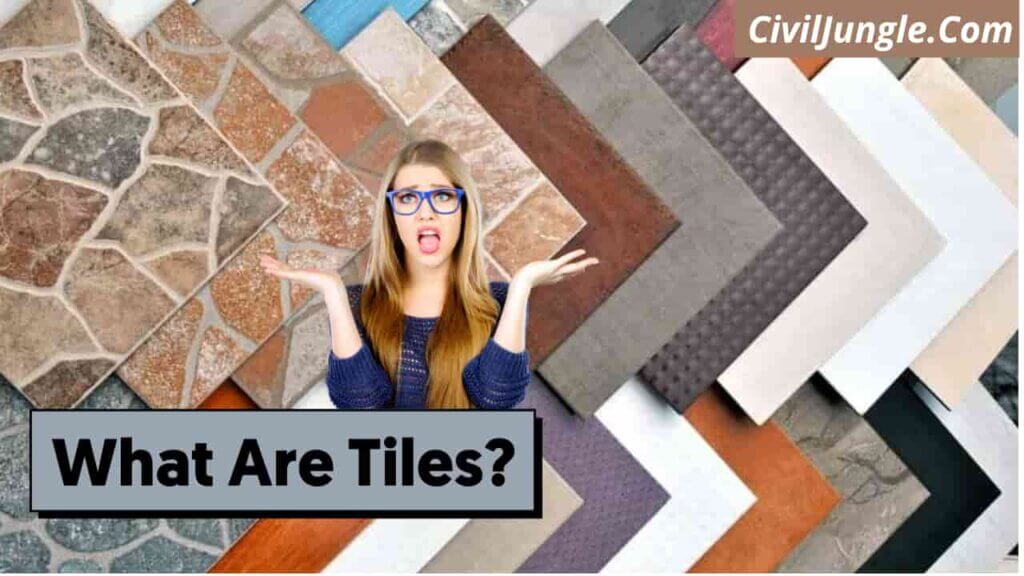Purpose of Tile Flooring in the House
Important Point
There are some essential purposes behind fitting tiles in the home, It is effortlessly found in the market and provides many kinds of designs, colors, and shapes. Tiles have a shiny fresh floor, which provides free wash.
The tiles are long-lasting design materials.
The flooring tiles used in the bedroom, living room, kitchen, drawing room, balcony, bath basin, etc. it is good for you to select tiles from a famous brand; I want to recommend you to use Lavish Ceramics floor tiles like:
Polished Glazed Vitrified Tiles
- Double charge tiles
- Glazed porcelain tiles
- Outdoor tiles
- Soluble salt tiles
- Wooden tiles
Also, read: What Is Water Cement Ratio | Water-Cement Ratio and Concrete Strength | Role of Water in Concrete
What Are Tiles?
A tile is a good development material, especially oval or quadrate size. It structures from solid materials like ceramic, metal, stone, and even glass or baked clay, used for designing floors, terraces, and walls.
Standard Size of Flooring Tiles
Floor tiles are in oval and quadrate sizes, and they come in different shapes to select. Many of the standard sizes of floor tiles, wall-size are given in the following,
Wall Tile Size
- 10-inch x 12 inch
- Eight inches x 10 inches is also bigger can use.
Floor Tile Size
- 18 in x 18 in
- 12 in x 12 in
- 12 in x 24 in
Some structured even build the bigger shape of tiles in sizes of 24”x48”, 36”x 36”, and 48”x 48”.
The more oversized tiles have a simple design and grace; they are toughly amazing on the floors. If you choose a fashionable and straightforward climate, big floor tiles are absolute for you, and if you decide on ageless tiles, then there is an unlimited option.
In kitchen flooring tiles, the 12-inch tiles are standard and designed from various materials such as ceramic, porcelain, and different kind of stone. The standard tile size for the bath is 8 inches, 4 inches, 6 inches, and 2 inches. Wall attire for bath floor and walls are tiny checker tiles to huge tiles, which can arrive meters in the distance.
Selecting the correct shape of floor tile is necessary to look your house a wonderful glow. Choosing a tiny bath floor tile shape, you should remember that big tiles generate a peaceful environment which is absolute for baths in remote places. Choose a massive figure of calm colors like oval or gray, or white tiles, which appear attractive in bathrooms and can design upright and plane.
How Much Time Do I Need for Installation of Tiles?
In the beginning, we will calculate the no. of tiles used for the floor in an sq. m unit.
Step-1 Calculates the Area of the Floor.
- Take the distance and breadth of your floor in the meter unit.
- Let the length is 11m, and the width is 10m.
- So it is an 11m x 10m room.
Step-2- Measurement the Area of the Floor
- Measure the width and the length of the room and multiply the two measurements together.
- So, area =length x width = 11m x 10m =110 sq.
Step-3 Calculate the Size of the Tiles.
- Take measurements of the tile chosen to design in the flooring area.
- Suppose the size of tile is 0.40 x 0.40 (40cm x 40cm)
Step-4 Calculate the Area of the Tile
- Area of tile= 0.30m x 0.30m = 0.9 sq. m.
Step-5 Calculates the No. of Tiles Necessary for a Floor
- Nos. of tiles = area of floor/ area of one tile = 90/0.9 = 100 nos.
- Note-always possibility of damage because sometimes piece needs some areas. So, always count 5% extra diffusion while measuring the tiles required for a floor.
- Nos of tiles= 100 +5% wastage= 100+ (100 x 0.05) = 100 + 5 = 105 nos.
Also, read: Classification of Stone Work | What Is Stone Masonry
How to Calculate Number of Tiles Needed for a Room?
Here, the following steps for caution of tiles.
- In skirting tiles measurement, a no of avoiding tiles is measured by dividing the room’s constant meter by the length of the skirting tile chosen.
- Let skirting tiles size is 20cm x 5cm.
- The above size tile is 0.20m in the tile length and 0.05m in the tile height.
- of skirting tiles= 36m/ 0.20m = 7.2
- Nos of skirting tiles= 8 m.
How to Calculate Skirting Tiles?
Here, the following steps for caution of skating tiles.
- The skirting amount calculates in the meter. So, to measure the no of skirting tiles needed to calculate the length of the floor.
- Take the measure of the room is 10m x 9m.
- Then, calculate the perimeter of the room.
- If you have the length and width of the room, then multiply the length and width twice and add it.
- Constant meter length of the room= (2 x 10m) + (2 x 9m) = 38m
- We have to subtract the length of doors because skirting does not offer the door choice.
- Size of door = 2m x 2.2m, length=2m.
- Absolute meter length of skirting = 38 m – 2m = 36m.
- So, 38m is the running meter of the room.
Also, read: What Is Concrete | 31 Different Types of Concrete
Tile Flooring
For flooring, vitrified tiles are the best bet since they are durable and can withstand heavy traffic. For walls, you can choose either ceramic or porcelain tiles as they are non-porous or do not absorb stains. For outdoors it’s best to opt for either matt finish or anti-skid tiles to avoid slips.
What Is Tile Flooring?
Tile flooring is a catch-all term used to describe any hard-wearing flooring made up of tiles, where the gaps among tiles have been filled with grout. Oftentimes, tile flooring is made of ceramic, a clay-based material.
What Is Subway Tile?
Subway tile gets its name from the look of the tiles in the New York City subway system, though those early tiles were actually made of white glass. Subway tile is by definition a rectangular, thick, low-fired, glazed ceramic tile, traditionally 3″ by 6″, though it comes in a variety of sizes for home use.
What Is the Best Tiles for Bathroom?
- Ceramic Tile is Durable and Easy to Clean: Ceramic tile is one of the best types to use in a bathroom. It’s durable, easy to clean, and comes in lots of available styles that fit your home’s design. Plus, ceramic tiles can be easy to work with, too.
- Porcelain Tiles are More Stain-Resistant: Porcelain tiles are more resistant to stains than ceramic tiles. However, they can be slippery when wet, making for a potentially unsafe bathroom floor, so be sure to use a mat or rug near the toilet and shower.
- Stone or Natural Stone Is Good for the Allergy-Prone: Stone or natural stone flooring is an excellent choice for people with allergies due to its non-porous texture, which won’t hold onto dust and particles. Natural stones also tend to absorb allergens more quickly than other types of floors do.
- Vinyl Tile Is Stylish and Inexpensive: If you’re looking for a bathroom flooring material that’s affordable and easy to install, vinyl tile is the way to go. Vinyl tile relies on low-cost materials. They also deliver high degrees of practicality. In addition, its waterproof resilience and comfortable surface make vinyl tile an easy bathroom flooring choice for families.
- Linoleum Tiles Are Better for the Environment: Linoleum tiles offer an environmentally friendly option for bathroom floors. It’s all thanks to recycled materials like linseed oil, cork powder, wood flour, ground limestone, and pigments.
- Glass Tiles Are Good for Depth and Aesthetics: The sleek look of glass tile flooring is appealing because it creates the illusion of depth and, if tinted, has a stained-glass effect.
- Laminate Floor Tiles Are Inexpensive But Risky: Plastic laminate tiles are an inexpensive and good choice for projects in small bathrooms. Laminate is durable and easy to keep clean, but it doesn’t do well with moisture, so it’s best for a half bathroom.
- Wood Flooring Is Rich But Requires Major Upkeep: Many people choose the warm and cozy appearance of wood flooring. While a stylish choice, wood flooring requires regular upkeep like refinishing or sanding.
- Cork Flooring Is Popular for a Creative Look: Cork flooring is an excellent choice for those looking for style and comfort while walking barefoot. The tiles come in multiple colors and are easy to install. First, though, you’ll need to seal them with polyurethane since they can absorb moisture through the subfloor.
What Is Rectified Tile?
A rectified tile is a tile that, in its production, has been finished so that all sides are exactly the same size, making the tile uniformed with precision. This allows for a minimum grout joint to make the floor appear as one large tiled area. In doing this, the tiles require less grout. Non-Rectified Tiles.
What Is Ceramic Tiles?
Ceramic tiles were once made by hand. Wet clay was fashioned into shape, sometimes with the help of a wooden mold, and then left to dry in the sun or fired in a small brick kiln. While a few artisans still craft ceramic tiles by hand, the majority of ceramic tiles made today go through a process known as dry pressing or dust pressing.
What Are Ceiling Tiles Made Of?
Ceiling tiles are typically made with mineral wool, fiberglass, gypsum, perlite, clay, cellulose or starch. Metal, glass and wood are also gaining popularity as specialty materials.
Standard Ceramic Tile Sizes
Standard floor tile sizes range from just two inches wide to a foot and a half. Now, the more common and fashionable sizes include 12”×12”, 18”×18”, 12”×24”, and even larger dimensions for floor tiles, and 8”×10” and bigger for wall tiles. Some manufacturers are producing even larger floor tiles in sizes of 24”×48”, 36”×36’, and 48”×48”.
Bathroom Tiles Size
| Area |
Recommended Sizes
|
| Small shower floor |
1-inch square
|
| Small shower walls |
1-inch square to 4-inch square
|
| Moderate or large shower walls |
4-inch to 15-inch by 30-inch
|
| Bathroom floor |
1-inch square to 12-inch square, or up to large-format
|
| Bathroom walls |
4-inch square up to 12-inch by 24-inch
|
Wall Tile Size
Over the years, tile sizes have grown dramatically. 20 years ago, 8×8 floor tiles and 4×4 wall tiles were in fashion and the more common sizes, but now, the more common and fashionable sizes include 12×12, 18×18, 12×24, and even larger for floor tiles, and 8×10 and larger for wall tiles.
Kitchen Wall Tile Sizes
If you want your kitchen to remain timeless in design, we suggest sticking with a classic field tile size such as a 3 x 6 subway tile or a 4 x 4 in a straight-set pattern. Or add some design detail with a herringbone pattern. Field tile will transcend trends, making your tile backsplash a sustainable design feature.
Best Size Tile for Shower Walls
For shower floors or pans, generally, you will want to have smaller-sized tiles, from 4 inches by 4 inches down to 1-inch by 1-inch mosaic tiles (4″ x 4″ x 1″).
How to Calculate How Many Tiles Needed for a Room?
Multiply the tile length by the width to figure the area that one tile will cover in square inches. Divide the result by 144 to convert it to square feet. Then, divide the area you’re tiling by the square footage of one tile to determine how many tiles you need. Again, round up to the nearest whole number.
If you choose six-by-six-inch tiles, each tile would cover 0.25 square feet (36 / 144). If the area of your wall or floor is 50 square feet, you would need 200 tiles at minimum to cover the area (50 / 0.25).
Floor Tile Installers Near Me
The labor cost for installing tiles is about $4 to $32 per square foot. Labor costs range from $4 to $14 per square foot for floor tiling, while those for a backsplash or countertop are about $25 to $32 per square foot.
How to Measure a Room for Tiles?
If you choose six-by-six-inch tiles (6″ x 6″), each tile would cover 0.25 square feet (36 / 144). If the area of your wall or floor is 50 square feet, you would need 200 tiles at minimum to cover the area (50 / 0.25).
How Much Tile Do I Need for a 10×10 Room?
Add up the square footage of all the areas to be tiled. Since a 10 by 10 ceramic tile is one square foot, the number of square feet equals the number of tiles you need to cover the floor space. However, you should allow for cutting tiles to fit or breakage, so add 20 percent to your measurement.
Divide the total number of tiles you need by 10. You should do this because 10 by 10 tiles are usually sold in boxes of 10, so you’ll need to know how many boxes of tile to buy. For example, if you calculated a total of 140 square feet, this works out to 11.67 boxes. You will buy full boxes of tiles, so round this up to the next full box. In this example you should buy 12 boxes.
Kitchen Wall Tiles
Backsplashes are an expanse of material that typically fills the gaps on a kitchen or bathroom wall between cabinets and a countertop, spanning the length of the countertop. Traditionally, these have ranged from small patches of backsplash that stretch above farmhouse sinks to the pre-2000s mosaic-style backsplashes that were often meant to match kitchen flooring.
Bathroom Floor Tiles
Accordingly, tile is an extremely common floor and wall bathroom material (although there are some good tile alternatives for bathroom showers). Tile repels water and is easy to clean with powerful cleaners to kill germs, bacteria, mold and other nastiness. But, there isn’t just one type of tile.
Bathroom Wall Tiles
Traditionally, tiles are used in wet areas of a bathroom (around the bath and within the shower enclosure) as a means to waterproof walls but there are now alternative materials to add decorative, waterproofing to bathroom walls.
Wooden Tiles
Wood-look tile is ceramic or porcelain tile that is designed to have the appearance of real wood. It often comes in planks, like real wood, but is also available in unique shapes more common to tiles.
Marble Floor Tiles
Marble is a very popular natural stone that is quarried and cut into slabs and tiles for a variety of residential and commercial building applications, including countertops, floors, and wall tiles. It is a metamorphic rock that forms when a sedimentary stone, such as limestone, is transformed under heat and pressure into a harder stone with beautiful color and veined patterns.
Black and White Tiles
This tile, called Grand Harlequin, comes in black, white and gray for a mind-bending visual illusion that’s perfect for smaller bathrooms. Bold and stylish, this tile is great for flooring or an accent wall, although you might want to go easy on it because of the geometrical illusion.
Plastic Tiles
A plastic tile block. Once they receive used plastic waste from vendors (Kabadi walas), the plastic is crushed, washed, mixed with fillers and then compressed to make tiles at the production unit based in Ghaziabad, Uttar Pradesh.
Natural Stone Tiles
Natural stone tile is exactly how the name sounds. It’s a non-man-made, all-natural material straight from Mother Earth! There’s a variety of different natural stones, like slate, granite, marble, limestone, travertine and sandstone. To learn more about each one, check out our other blog, here.
Exterior Wall Tiles
Exterior wall tiles are more durable than indoor tiles and are built to withstand harsh weather conditions, such as sunlight, rain, humidity, etc. Outside wall tiles are resistant to acid rain and hence, can retain their appearance and strength longer. Another difference between tiles for exterior wall and interior wall lies in their texture. Exterior wall tiles, upon installation, have a rougher texture than interior wall tiles.
Hexagon Floor Tile
In geometry, the hexagonal tiling or hexagonal tessellation is a regular tiling of the Euclidean plane, in which exactly three hexagons meet at each vertex. It has Schläfli symbol of {6,3} or t{3,6} (as a truncated triangular tiling). English mathematician John Conway called it a hextille.
Replacing Ceramic Tile
Here, the following steps for change of replacing ceramic tiles
- Remove the Grout
- Loosen the Tile
- Chisel Out the Pieces
- Set the New Tile
- Fill the Joint with Grout
- Allow the Grout to Dry
Installing Ceramic Tile
Bathroom Tile Contractors Near Me
Most homeowners pay an average of $7 to $25 per square foot. Tiling a bathroom floor differs from tiling walls because working around sinks, toilets and other fixtures can make it a complicated job. Most homeowners pay an average of $300 to $600 to tile the floors of a standard bathroom.
Bathroom Tile Installers Near Me
All in all, the average price for a bathroom retiling is $2,000 including labor, but the range typically falls anywhere between $450 and $10,000.
Installing Tile Floor
When you are tiling, the ground underneath your tiles needs to be well prepared. You achieve this by providing a protective layer of underlayment on top of it. A cement board or backer board is the best for this purpose. The boards protect against moisture in flooring materials.
Rubber Tiles for Gym
Rubber: rubber is the flooring of choice at most gyms, so it may be the best option for a home gym. It can prevent slips and falls while also absorbing impact, ideal for high-impact cardio workouts or working out with free weights. Rubber flooring won’t dent, scratch, or gouge as foam or hardwood flooring might.
Tile Installers Near Me
Professional installation adds $5 to $10 per square foot, depending on the amount of prep work required, putting the total average cost to install a tile floor at $7 to $14 per square foot. Expect to pay $1,050 to $2,100 to install a tile floor in a 10×15-foot room (150 square feet).
Tile and Flooring Near Me
| Floor Size | Room Dimensions | Average Cost Range (Labor and Material) |
| 144 sq.ft. | 12′ x 12′ | $1,296 – $30,816 |
| 200 sq.ft. | 10′ x 20′ | $1,800 – $42,800 |
| 500 sq.ft. | 20′ x 25′ | $4,500 – $107,000 |
| 1,000 sq.ft. | 20′ x 50′ | $9,000 – $214,000 |
Tile Installer
Tile installers, sometimes called tile setters, cut tiles using wet saws, tile scribes, or handheld tile cutters. They then use trowels of different sizes to spread mortar or a sticky paste, called mastic, evenly on the work surface before placing the tiles.
Like this post? Share it with your friends!
Suggested Read –
- What is Vitrified Tile
- Minimum Size Living Room
- What Is Traversing in Surveying | Types | Method | Definition
- Difference Between One Way Slab and Two Way Slab | What is Slab
- What Is Bar Bending Schedule | Preparation as Per Bs 4466 | Tolerances as Per Bs 4466
- Prismatic Compass Survey Vs Surveyor Compass. | Least Count of Prismatic Compass & Surveyor Compass
- Benchmark in Surveying | TBM in Surveying | GTS Benchmark| Permanent Benchmark| Arbitrary Benchmark
- What Is Unit Weight | What Is Density | What Is Unit Weight Material | Unit Weight Building Materials
- What Is Pier Foundation | Types of Drilled Piers | Advantages and Disadvantages of Drilled Pier Foundations
- What Is Diversion of Headworks (Rivers) | Types of Diversion Headworks | Component Parts of Diversion Headworks (Rivers)
Originally posted 2022-04-29 17:15:36.






Leave a Reply